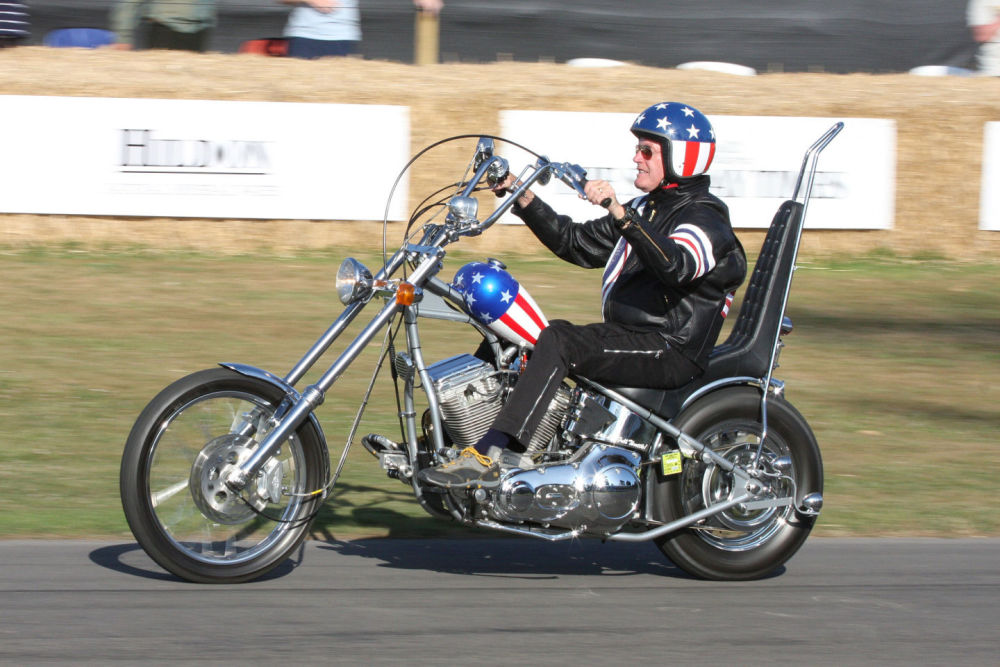
American classic Chopper motorcycle, a timeless history of modification | Enginediy
Chopper is a motorcycle that has been in California since the late 1950s. Usually Chopper completely modified the steering angle and lengthened the front fork to extend the appearance. They are made from modified (shredded) original motorcycles, or assembled from scratch.

The characteristics of Chopper are: the front end is longer, the front fork is extended, the front fork angle is increased, the hard tail frame, the super high ape-shaped suspension or the extremely short handlebar, the elongated or stretched frame, and the larger than the ordinary front wheel. The most well-known Chopper is also the two customized Harley-Davidsons in the 1969 movie "Easy Rider".

The Bob-Job era (1946-1959)
Before Chopper, it was Bobber. By removing extra parts of motorcycles, it made it lighter, faster, and more beautiful in appearance. It was loved by simple riders.
An early example of Bobber was the Indian Sport Scout Bob-Job in 1940, touring in the Motorcycle Art Exhibition in 1998.

The first batch of Choppers were made in the United States. Soldiers and others who returned home after World War II began to modify cars and motorcycles. These early modified motorcycles were called "Bobber". There are many things in common between Bobber and Chopper. Features, by modifying the frame tube, to achieve the purpose of longer riding.

1948-harley-panhead
Some of the earliest Choppers appeared in the late 1950s and were made by members of motorcycle clubs in the Los Angeles area. The earliest Choppers were often prototypes of Harley motorcycles.
As time passed, Chopper more and more realized a certain appearance, rather than mainly based on performance modification.

In Europe, the era when Chopper was invented and popularized in the United States was roughly the same. Riders modified their motorcycles in different ways, mainly British brands such as Triumph, BSA, Norton, etc., to achieve different appearance, performance goals and rides. The posture, the resulting motorcycle is called Cafe Racer, is completely different from Chopper.
With the popularity of Chopper, coupled with the exposure of the 1969 classic "Easy Rider" and other movies, some motorcycle brands began to add Chopper series styles in their factories. But no factory is willing to do perfect things, such as abandoning the rear suspension to get the classic Chopper appearance, so these motorcycles are given the name of "factory custom" instead of being regarded as Chopper.
Late 1950s to 1960s-Early Chopper
By the early 1960s, enough people had begun to modify motorcycles, but it was still dominated by large Harley motorcycles. Motorcycle tires are replaced with narrower, forward-mounted spikes instead of standard large footrests, standard headlights and fuel tanks are replaced by smaller lamp holders and fuel tanks, and upgraded chrome-plated parts are often added. In this era, we believe that Chopper came into being today.

In the 1960s, candy-colored paint, multi-colored, metallic flake-like paint with different patterns, became a trend, which can further express one's own personality and artistry.

1970s: the iconic Chopper
The great success of the 1969 movie "Easy Rider" promoted Chopper worldwide. The subculture known to a relatively small number of enthusiasts in several regions of the United States has become a global phenomenon. In the late 1960s, the first European Chopper manufacturers appeared, such as the "Swedish Chopper" style.
The number of shops that make Chopper has doubled, the number of ready-made Chopper parts suppliers has also doubled, and there are high-handle bars. The store also customized exhaust pipes and launched many after-sales kits from the late 1960s to the 1970s. The law requires a fixture, so the vertical backrest called the sissy bar has become a popular installation method, usually higher than the rider's head.

Although the reduced weight and lowered seat position improve handling and performance, the main reason for making Chopper is to show off to others. Style trumps practicality, especially as the forks become longer and longer processing times. As one rider said: "You can't turn well, but you do look good."
1980s and 1990s: improved engineering and after-sales suppliers
In 1984, Harley-Davidson, who has always used the Chopper style, introduced the Softail design, which hides the rear shock absorber under the engine, making it look like a hard tail. Softail got a lot of styling inspiration from Chopper, including the narrow 21-inch front wheel.

For some time, the factory seemed to do more work on handicrafts than on wild innovations. Although individual builders are still making long motorcycles, the trend is toward more moderate geometry.
The basic knowledge of how to build good performance but still beautiful Chopper is becoming more and more common. With the improvement of materials, manufacturing and knowledge, the performance of better Chopper has also been improved. More powerful engines drive the need for stronger frames, brakes and greater tire grip. These trends worked together so that by the end of the 1990s, the modern Chopper was more powerful.
21st Century: Reality TV
The millennium began with the cable television network "Discovery", which created many TV shows around several Chopper manufacturers. The first was the special motorcycle mania of 2000, followed by Jesse James, a builder of Long Beach, California, who was hailed as creating a "new type of reality TV" around Chopper.

Celebrity builders on cable TV shows have gained a lot of attention. West Coast companies like Jesse James have successfully produced expensive Chopper, as well as various Chopper-themed merchandise brands, such as clothing, car accessories and stickers.
2010: Strong opposition, glitz and old school revival
Many builders avoided Harley’s model motors and frames, and began to use neglected cars (such as Yamaha XS-650, old Harley Sportsters, and various so-called Japanese UJM four-cylinder air-cooled from the 1980s) to make Choppers.

Another aspect of resistance is to return to traditional styles. Indian Larry and Paul Cox and other New York City builders from Psycho Cycles are generally believed to have led the movement back to the old-school Chopper during this period. Indian Larry was an early featured builder in the "Biker Build-Off" series on Discovery, and won all three supplementary competitions, highlighting his traditional style.
The three-inch wide belt drive and the 120 cubic inch motor are still favored by many people, but people are increasingly using Shovelhead motors and chain drive prime movers to manufacture. The springboard, even the beam fork, is making a comeback again.

Article from: GETmoto

Comments
Leave a comment